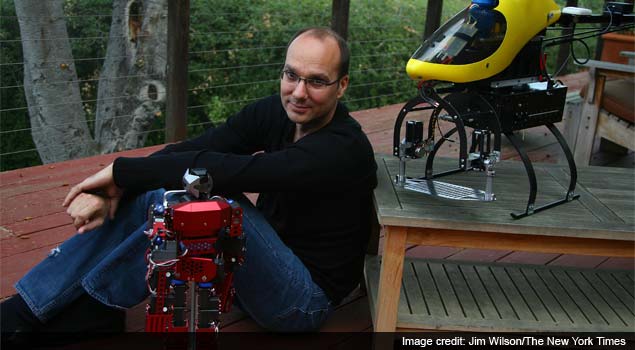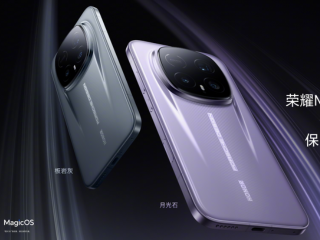- Home
- Others
- Others News
- Envisioning a robotic future, Google puts its cash to work
Envisioning a robotic future, Google puts its cash to work

If Amazon can imagine delivering books by drones, is it too much to think that Google might be planning to one day have one of the robots hop off an automated Google Car and race to your doorstep to deliver a package?
Google executives admit that robotic vision is a "moonshot." But it appears to be more realistic than Amazon's proposed drone delivery service, which Jeff Bezos, Amazon's chief executive, revealed in a television interview the evening before one of the biggest online shopping days of the year.
(Also see: Amazon testing delivery packages using drones, CEO Bezos says)
Over the last half-year, Google has quietly acquired seven technology companies in an effort to create a new generation of robots. And the engineer heading the effort is Andy Rubin, the man who built Google's Android software into the world's dominant force in smartphones.
The company is tight-lipped about its specific plans, but the scale of the investment, which has not been previously disclosed, indicates that this is no cute science project.
At least for now, Google's robotic effort is not something aimed at consumers. Instead, the company's expected targets are in manufacturing - like electronics assembly, which is now largely manual - and competing with companies like Amazon in retailing, according to several people with specific knowledge of the project.
A realistic case, according to several specialists, would be automating portions of an existing supply chain that stretches from a factory floor to the companies that ship and deliver goods to a consumer's doorstep.
"The opportunity is massive," said Andrew McAfee, a principal research scientist at the MIT Center for Digital Business. "There are still people who walk around in factories and pick things up in distribution centers and work in the back rooms of grocery stores."
Google has recently started experimenting with package delivery in urban areas with its Google Shopping service, and it could try to automate portions of that system. The shopping service, available in a few locations like San Francisco, is already making home deliveries for companies like Target, Walgreens and American Eagle Outfitters.
(Also see: Google testing Shopping Express same-day delivery service to rival Amazon Prime)
Perhaps someday, there will be automated delivery to the doorstep, which for now is dependent on humans.
"Like any moonshot, you have to think of time as a factor," Rubin said. "We need enough runway and a 10-year vision."
Rubin, the 50-year-old Google executive in charge of the new effort, began his engineering career in robotics and has long had a well-known passion for building intelligent machines. Before joining Apple Computer, where he initially worked as a manufacturing engineer in the 1990s, he worked for the German manufacturing company Carl Zeiss as a robotics engineer.
"I have a history of making my hobbies into a career," Rubin said in a telephone interview. "This is the world's greatest job. Being an engineer and a tinkerer you start thinking about what you would want to build for yourself."
He used the example of a windshield wiper that has enough "intelligence" to operate when it rains, without human intervention, as a model for the kind of systems he is trying to create. That is consistent with a vision put forward by the Google co-founder Larry Page, who has argued that technology should be deployed wherever possible to free humans from drudgery and repetitive tasks.
The veteran of a number of previous Silicon Valley startup efforts and twice a chief executive, Rubin said he had pondered the possibility of a commercial effort in robotics for more than a decade. He has only recently come to think that a range of technologies have matured to the point where new kinds of automated systems can be commercialized.
Earlier this year, Rubin stepped down as head of the company's Android smartphone division. Since then he has convinced Google's founders Sergey Brin and Page that the time is now right for such a venture, and they have opened Google's checkbook to back him. He declined to say how much the company would spend.
Rubin compared the effort with the company's self-driving car project, which was started in 2009. "The automated car project was science fiction when it started," he said. "Now it is coming within reach."
He acknowledged that breakthroughs would still be necessary in areas like software and sensors, but said that hardware issues like mobility and moving hands and arms had been resolved.
Rubin has secretly acquired an array of robotics and artificial intelligence startup companies in the United States and Japan.
Among the companies are Schaft, a small team of Japanese roboticists who recently left Tokyo University to develop a humanoid robot, and Industrial Perception, a startup here that has developed computer vision systems and robot arms for loading and unloading trucks. Also acquired were Meka and Redwood Robotics, makers of humanoid robots and robot arms in San Francisco, and Bot & Dolly, a maker of robotic camera systems that were recently used to create special effects in the movie "Gravity." A related firm, Autofuss, which focuses on advertising and design, and Holonomi, a small design firm that makes high-tech wheels, were acquired as well.
The seven companies are capable of creating technologies needed to build a mobile, possibly humanoid, robot. Rubin said he was pursuing additional acquisitions.
Unlike Google's futuristic X lab, which does research on things like driverless cars and the wearable Google Glass device, the robotics effort - moonshots aside - is meant to sell products sooner rather than later. It has not yet been decided whether the effort will be a new product group inside Google or a separate subsidiary, Rubin said.
The Google robotics group will initially be based here in Palo Alto, with an office in Japan. In addition to his acquisitions, Rubin has begun hiring roboticists and is bringing in other Google programmers to assist in the project.
While Google has not detailed its long-term robotics plans, Rubin said that there were both manufacturing and logistics markets that were not being served by today's robotic technologies, and that they were clear opportunities.
This is not the first time that Google has strayed beyond the typical confines of a tech company. It has already shaken up the world's automobile companies with its robot car project. Google has not yet publicly stated whether it intends to sell its own vehicles or become a supplier to other manufacturers. Speculation about Google's intentions has stretched from fleets of robotic taxis moving people in urban areas to automated delivery systems.
Rubin said that one of his frustrations about today's consumer electronics industry was its complexity. He is hoping robotics will be different.
"I feel with robotics it's a green field," he said. "We're building hardware, we're building software. We're building systems, so one team will be able to understand the whole stack."
© 2013, The New York Times News Service
Catch the latest from the Consumer Electronics Show on Gadgets 360, at our CES 2026 hub.
Related Stories
- Samsung Galaxy Unpacked 2025
- ChatGPT
- Redmi Note 14 Pro+
- iPhone 16
- Apple Vision Pro
- Oneplus 12
- OnePlus Nord CE 3 Lite 5G
- iPhone 13
- Xiaomi 14 Pro
- Oppo Find N3
- Tecno Spark Go (2023)
- Realme V30
- Best Phones Under 25000
- Samsung Galaxy S24 Series
- Cryptocurrency
- iQoo 12
- Samsung Galaxy S24 Ultra
- Giottus
- Samsung Galaxy Z Flip 5
- Apple 'Scary Fast'
- Housefull 5
- GoPro Hero 12 Black Review
- Invincible Season 2
- JioGlass
- HD Ready TV
- Laptop Under 50000
- Smartwatch Under 10000
- Latest Mobile Phones
- Compare Phones
- Vivo Y500i
- OnePlus Turbo 6V
- OnePlus Turbo 6
- Itel Zeno 20 Max
- OPPO Reno 15 Pro Mini 5G
- Poco M8 Pro 5G
- Motorola Signature
- Vivo Y50e 5G
- Lenovo Yoga Slim 7x (2025)
- Lenovo Yoga Slim 7a
- Realme Pad 3
- OPPO Pad Air 5
- Xiaomi Watch 5
- Huawei Watch 10th Anniversary Edition
- Acerpure Nitro Z Series 100-inch QLED TV
- Samsung 43 Inch LED Ultra HD (4K) Smart TV (UA43UE81AFULXL)
- Asus ROG Ally
- Nintendo Switch Lite
- Haier 1.6 Ton 5 Star Inverter Split AC (HSU19G-MZAID5BN-INV)
- Haier 1.6 Ton 5 Star Inverter Split AC (HSU19G-MZAIM5BN-INV)
















